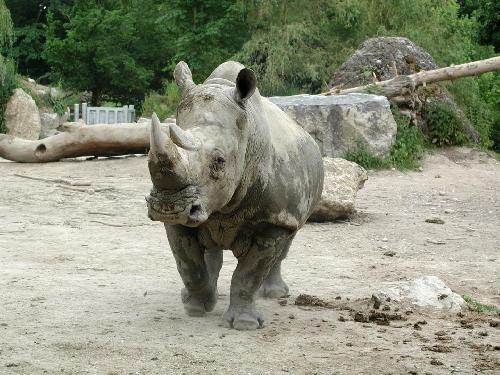White rhinoceroses are among the largest rhinoceroses in the world. Their natural habitat is southern Africa. Due to the great demand for their horn, the animals are poached intensely and threatened with extinction. The International Union for Conservation of Nature (IUCN) therefore placed the southern white rhinoceros (Ceratotherium s. simum) on the red list of endangered animals. In zoos, southern white rhinoceroses are considered easy to keep. The reproductive success of captive animals has not been so good, however.
The wild animal experts Annika Posautz, Felix Knauer and Chris Walzer from the Research Institute of Wildlife Ecology at Vetmeduni Vienna investigated, among other things, how the housing conditions of southern white rhinoceroses differed in zoos across Europe and which health problems were most common. "We wanted to find out what sorts of problems exist in European zoos and what could be improved. With the exception of the reproductive tract, little is known in the scientific literature about the health of captive rhinos. The animal management also differs from zoo to zoo," explains Posautz, the study's first author.
Of 70 zoos contacted, 45 responded to the online survey. One zoo from Israel also took part in the study. The collected data reflect a total of 159 rhinoceroses.
 The southern white rhinoceroses are considered easy to keep in captivity. Credit: Photo: Chris Walzer/Vetmeduni Vienna
The southern white rhinoceroses are considered easy to keep in captivity. Credit: Photo: Chris Walzer/Vetmeduni Vienna
Most common health problems with skin, digestive tract and reproductive organs
The survey showed that dermatological, gastrointestinal and reproductive cases accounted for most of the health problems among the animals. The dermal cases often involved wounds resulting from aggressive interactions with other animals. Colic and enteritis were among the most common gastrointestinal problems reported for white rhinoceroses.
"In many cases, health checks are conducted only superficially. The actual cause of a health problem can therefore rarely be found," Posautz believes. "That also has to do with the fact that, unfortunately, zoo veterinarians are still reluctant to sedate the rhinos for an in-depth check-up and therapy." Many veterinarians believe that anaesthetizing wild animals involves enormous effort and high risk.
Prophylactic treatment with antibiotics hides actual disease
What surprised and worried the researchers the most was the regular, long-term use of antibiotics and anti-inflammatory drugs without an exact diagnosis. "Such drugs are good for short-term therapies. We believe that their long-term use without a specific diagnosis represents a danger to the animals," Posautz says. "The actual health issues affecting the animals remain hidden."
The wild animal expert and veterinarian Posautz recommends: "Regular check-ups, such as parasitological screening and blood tests, could prevent many health problems before they arise. Consideration must also be given to medical training programmes and the use of sedatives for early, in-depth health checks and therapies."
source: University of Veterinary Medicine -- Vienna